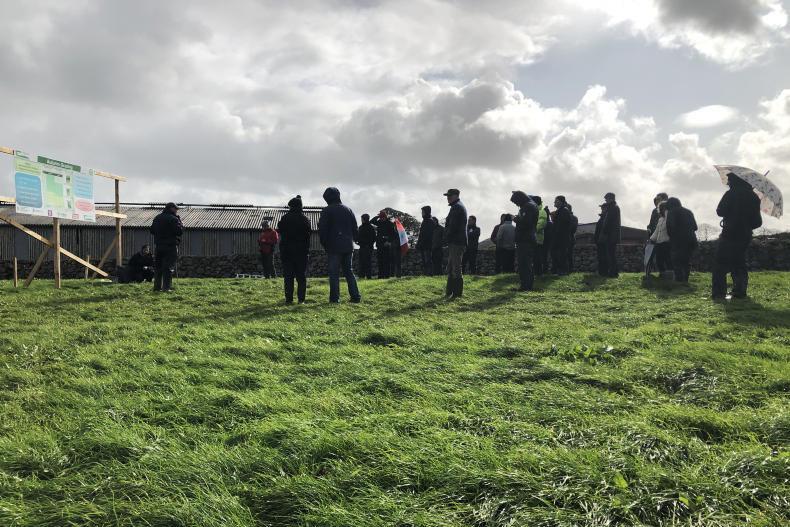“The last grazing of 2019 is essentially your first grazing of 2020” – that was the key message from a very wet and cold Newford Farm in Athenry last Tuesday week. A group of 40-plus farmers and Teagasc advisers descended on the farm as part of the Teagasc Grass10 autumn series.
Grass10 programme manager John Maher led proceedings, while Grass10 adviser John Douglas and Teagasc researcher Brian McCarthy also presented stands. Newford Farm manager Iarlaith Collins and resident Teagasc technician Michael Fagan were on hand to discuss matters from a Newford perspective.
Grazing planner
It was Douglas who highlighted the function of autumn grazing as a platform for successful spring grazing: “The last grazing of 2019 is essentially your first grazing of 2020.” He went on to explain that “the grass you have on your farm next spring is going to be grown now”. With this in mind, he stressed the importance of correctly managing the final rotation this autumn.
Maher stressed the importance of a grazing planner: “We have two objectives this autumn. The first is to make best use of autumn grass. Every extra day an animal is at grass this autumn is worth about €1.80 in cost savings. Our second objective is to set the farm up properly for grazing next spring.” The autumn grazing planner targets 60% of land to be closed by 1 November – that ground will have grass present early next spring.

Maher acknowledged the difficult weather conditions so far this autumn but he warned farmers about the consequences of not getting ground grazed off: “If we don’t get to graze heavy covers before closing, there will be a number of consequences. Firstly, we are going to lose a portion of grass dry matter over the winter. The grass will reduce. That’s inevitable.”
We were forced to wean four to five weeks earlier than we had hoped due to the conditions
But he said the knock-on effect next spring could be even more serious: “When we get out next spring to graze this heavy cover, there is a strong chance that we will be left with a white butt after grazing and the recovery and regrowths are going to be very slow. If there is a soil fertility issue on top of this, the recovery time is going to be even longer.”
Maher suggested farmers should strike a balance between getting ground grazed off and not poaching ground at the same time. He said proper grazing management is essential and explained the merits of strip grazing and block grazing: “Most importantly, you are going to need a reel and pigtails to manage grazing properly.”
While the farm has a good cover of grass (about 950kg DM/ha AFC), ground conditions are extremely bad.
Collins said: “We were forced to wean four to five weeks earlier than we had hoped due to the conditions.” On the day, all weanlings were outdoors and 60% of the dry cows were outside. The rest of the cows and all beef cattle were housed. The 60% of the cows have since been housed too.
“We will do our best to keep the weanlings out for as long as possible. Hopefully another month anyway and they will get through the grass we have left on the farm,” he said. Weanlings are currently receiving 2kg of concentrates per head per day in the yard, after being upped from the 1kg they were receiving prior to weaning.
We have lost about three weeks of feed already and that’s going to pretty much erode our buffer
It was suggested that weanlings should be cut back down to 1kg of concentrates to encourage them to graze more grass per day. This would speed up the closing process and possibly ensure all ground is grazed before housing. This idea was met with mixed opinions, with some citing low grass DM and low grass sugars as being potentially very damaging to weanling performance.
Fagan pointed out the concerns the farm now has as a result of early housing: “We need 1,100t of silage on this farm for the winter. That’s based off a five-month winter for the cows, four months for the weanlings and about two months for beef stock.”
Prior to any housing, the farm had 1,200t in stock. “We have lost about three weeks of feed already and that’s going to pretty much erode our buffer. We will be hoping for a good spring and to get cattle out next February,” Fagan added. Silage tests from first-cut bales returned positive at 72%-76% DMD. The second-cut pit silage will be tested soon.






 This is a subscriber-only article
This is a subscriber-only article










SHARING OPTIONS: